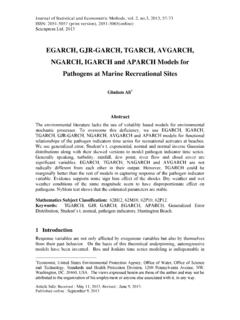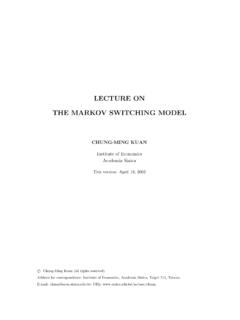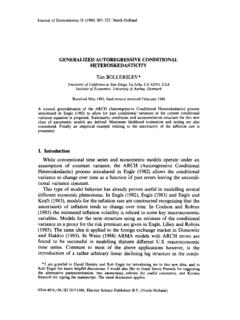Transcription of The Elements of Financial Econometrics - Princeton University
1 Mathematics Monograph Series 30 The Elements of Financial Econometrics Jianqing Fan Qiwei Yao SCIENCE PRESSB eijingResponsible Editor: yuzhuo Chen Copyright 2015 by Science Press Published by Science Press 16 Donghuangchenggen North Street Beijing 100717, P. R. China Printed in Beijing All rights reserved. No part of this publication may be reproduced, stored in a retrieval system, or transmitted in any form or by any means, electronic, mechanical, photocopying, recording or otherwise, without the prior written permission of the copyright owner. ISBN 978-7-03-043398-5 (Beijing)PrefaceThis is an introductory textbook for Financial Econometrics at the master s are assumed to have some background in calculus, linear algebra, statistics,and probability, all at undergraduate level. Knowledge in economics and finance isbeneficial but not book grew out of the lecture notes for the Financial Econometrics coursetaught by Jianqing Fan for Master in Finance students at Princeton University since2003 and for Master in Financial Engineering students at Fudan University since2011.
2 The audiences are always very broad with diverse background in mathematics,physics, computer science, economics, or finance. Those talented students wish tolearn fundamentals of Financial Econometrics in order to work in Financial industryor to pursue a degree in related fields. The challenges are to give all of themsufficient Financial Econometrics knowledge upon the completion of the class. Thistext book is written with the aim to achieve such an ambitious trust that the book will be of interest to those coming to the area for thefirst time, to readers who already have economics and finance background but wouldlike to further sharpen their quantitative skills, and also to those who have strongquantitative skills and would like to learn how to apply them to finance. Application-oriented analysts will also find this book useful, as it focuses on methodology andincludes numerous case studies with real data sets.
3 We purposely keep the levelof mathematics moderate, as the power of the quantitative methods can be under-stood without sophisticated technical details. We also avoid the cook book style ofwriting, as good understanding of statistical and econometric principles in financeenable readers to apply the knowledge far beyond the problems stated in the illustration with real Financial data is throughout the book. We also indi-cate, whenever possible, where to find the relevantRcodes to implement the variousmethods. Due to the nature of the subject, it is inevitable that we occasionallystep into more sophisticated techniques which rely on more advanced mathematics;such sections are marked with and can be ignored for beginners. Most technicalarguments are collected in a Complements section at the end of some chapters,iiPrefacebut key ideas are left within the main body of the is Financial Econometrics ?
4 Broadly speaking, it is an interdisciplinary sub-ject that uses statistical methods and economic theory to address a variety of quan-titative problems in finance. These include building Financial models, testing finan-cial economics theory, simulating Financial systems, volatility estimation, risk man-agement, capital asset pricing, derivative pricing, portfolio allocation, proprietarytrading, portfolio and derivative hedging, among others. Financial Econometrics isan active field of integration of finance, economics, probability, statistics, and ap-plied mathematics. Financial activities generate many new problems and products,economics provides useful theoretical foundation and guidance, and quantitativemethods such as statistics, probability and applied mathematics are essential toolsto solve quantitative problems in finance. Professionals in finance now routinelyuse sophisticated statistical techniques and modern computation power in portfoliomanagement, proprietary trading, derivative pricing, Financial consulting, securitiesregulation, and risk the class was first taught in 2003, there were very few books on financialeconometrics.
5 The books that have strong impact on our preparation of lecturenotes are Campbell et al. (1997) and Fan and Yao (2003). With one semester ofteaching, we can only cover the important Elements of Financial Econometrics . Weuse this name as the title of the book, as it also reflects the modulus aspect of thebook. This allows us to expand this textbook to cover other fundamental materialsin the future. For example, Simulation methods in finance and Econometrics ofcontinuous time finance are taught at Princeton , but are not in this book nor inFudan s Financial engineering class due to time constraints. Another important topicthat we wish to cover is the analysis of high-frequency Financial book consists of two integrated parts: The first four chapters are on timeseries aspects of Financial Econometrics while the last five chapters on cross-sectionalaspects.
6 The introduction in Chapter 1 sets the scene for the book: using twofinancial price time series we illustrate the stylized features in Financial efficient markets hypothesis is deliberated together with statistical tests forrandom walks and white noise. A compact view of linear time series models isgiven in Chapter 2, including ARMA models, random walks, and inference withtrends. We also include a brief introduction on the exponential smoothing basedforecasting techniques for trends and momentum, which are widely used in financialindustry. Chapter 3 introduces various heteroscedastic volatility models. A compactintroduction to state space models including the techniques such as Kalman filter andparticle filters is included as an appendix. Chapter 4 contains some selective topicsin multivariate time series analysis. Within the context of vector autoregressivemodels, we also introduce the topics such as Granger causality, impulse responsePrefaceiiifunctions, and cointegration, as they play important roles in economics and second begins with Chapter 5, which introduces portfolio theory and derivesthe celebrated capital asset model .
7 We also introduce statistical techniques to testsuch a celebrated model and provide extensive empirical studies. Chapter 6 extendsthe capital asset pricing model to multi-factor pricing model . The applications ofthe factor models and Econometrics tests on the validity of such pricing models areintroduced. In addition, principal component analysis and factor analysis are brieflydiscussed. Chapter 7 touches several practical aspects of portfolio allocation andrisk management. The highlights of this chapter include risk assessments of largeportfolios, portfolio allocation under gross-exposure constraints, and large volatilitymatrix estimation using factor models and covariance regularization. Chapter 8 de-rives the capital asset pricing model from consumption, investment, and saving pointof view. This gives students different perspective on where the Financial prices comefrom and a chance to appreciate its differences from pricing Financial 9 calculates the prices implied by the models of returns.
8 It gives us an ideaof what the fundamental price of a stock is and how the prices are related to thedividend payments and short-term interest people have been of great help to our work on this book. Early draftsof this book has been taught to about over five hundred students and there areour enthusiastic readers. In particular, we are grateful to Yingying Fan, Yue Niu,Jingjing Zhang, Feng Yang, Weijie Gu, Xin Tong, Wei Dai, Jiawei Yao, Xiaofeng Shi,and Weichen Wang for their gracious assistance of teaching Financial Econometricsclass at Princeton . R ene Carmona provides us his course outlines on FinancialEconometrics that helps the selection of the topics of the course. Many treatmentsof ARIMA models are inspired by the lecture notes of George Tiao. Alex Furgerand Michael Lachans spend a great amount of their precious time to proof-read thefinal version of the book.
9 We are very grateful to their contributions and would like to thank to Yacine Ait-Sahalia and Yazhen Wang for stimulatingdiscussions on the topic and Shaojun Guo for formatting the references of the are indebted to Jiaan Yan for his encouragement and support to publish this bookin China and to Xiongwen Lu for inviting us to teach the course in Fudan would also like to thank to Yuzuo Chen for providing various editorial Fan s research was generously supported by the National Science Foun-dation and National Institutes of Health of the USA, and Academy of Mathematicsand System Science and National Center for Mathematics and Interdisciplinary Sci-ences, Chinese Academy of 2014 Jianqing Fan, PrincetonQiwei Yao, LondonContentsPrefaceChapter 1 Asset One-period simple returns and gross Multiperiod Log returns and continuously Adjustment for Bond yields and Excess Behavior of Financial return Stylized features of Financial Efficient markets hypothesis and statistical models for Tests related to efficient markets Tests for white Remarks on the Ljung-Box test.
10 Tests for random Ljung-Box test and Dickey-Fuller Appendix: Q-Q plot and Jarque-Bera Q-Q Jarque-Bera Further reading and software 2 Linear Time Series Stationary ARMA Moving average Autoregressive Autoregressive and moving average Nonstationary and long memory ARMA Random ARIMA model and exponential FARIMA model and long memory processes .. Summary of time series model selection using ACF, PACF and EACF .. Fitting ARMA models: MLE and Least squares Gaussian maximum likelihood Illustration with gold A snapshot of maximum likelihood methods .. model diagnostics: residual Residual Goodness-of-fit tests for model identification based on information Stochastic and deterministic Trend Augmented Dickey-Fuller An Forecasting ARMA Forecasting trends and momentum of Financial Appendix: Time series analysis in Start up with R-functions for time series TSA an add-on 3 Heteroscedastic Volatility ARCH and garch ARCH garch Stationarity of garch Fourth Forecasting Estimation for garch Conditional maximum likelihood model Applications of garch Asymptotic properties.





